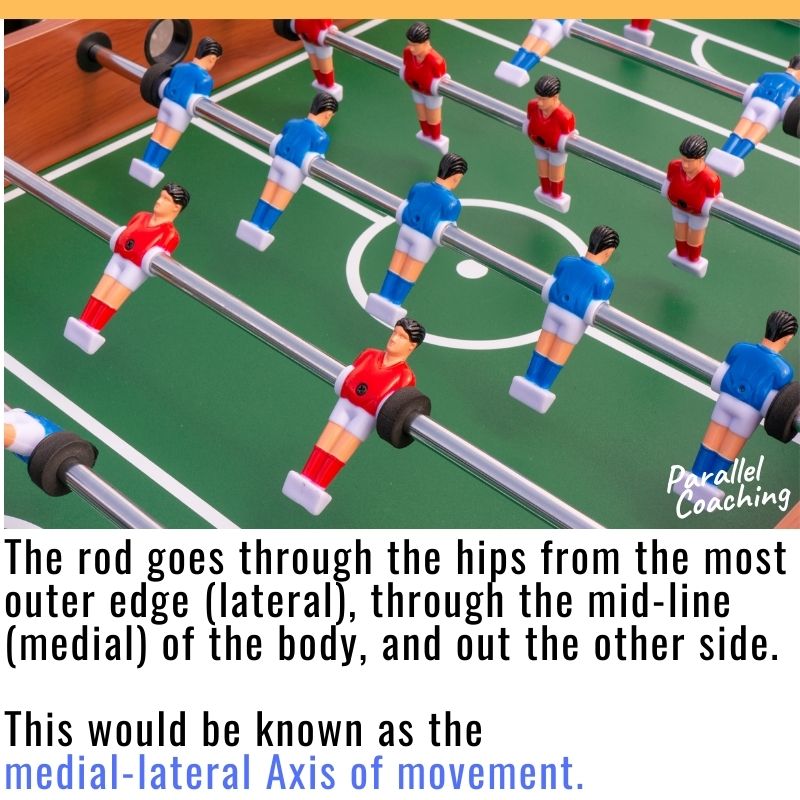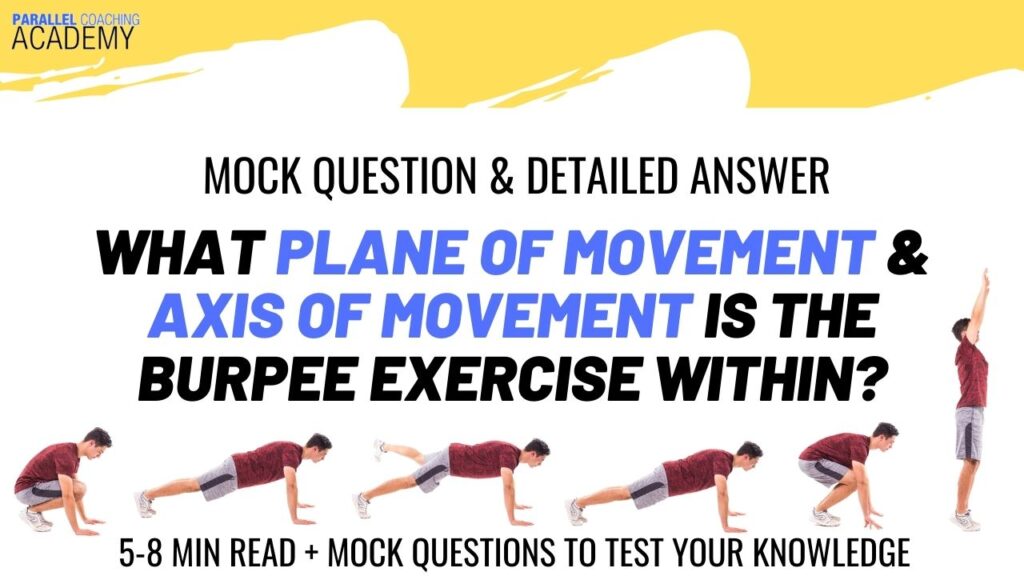A common question in the Level 3 anatomy and physiology exam is “What plane of movement and axis of movement is the burpee exercise within?” Here we will explore the answer in-depth so you can be confident in your knowledge.
Whenever you’re tackling mock questions or your final fitness exam the first step is:
To extract the keywords.
By extracting the keywords you can identify the
‘key phrases’, ‘topics’, and any ‘relevant information’.
Now your brain can start searching for all the stored knowledge about these keywords and help find the correct answer.
Let’s extract the keywords from the mock question:
What plane of movement and axis of movement is the burpee exercise within?
- Plane of movement
- Axis of Movement
- Burpee Exercise
By doing this we can now assign this question to module 4 of the level 3 Anatomy and Physiology exam – “The Body In Motion“
We can also see the ‘Burpee’ exercise is included… you are being asked to assign your anatomy knowledge
to the principles of training and a specific exercise.
Remember… as a FITPRO you are ultimately a mechanic of the body. You are curious about what makes up the body (all the parts of the anatomy), how all these parts function together (the body’s physiology)…
And how exercise, physical activity, nutrition, and mindset affect a client’s A&P.
Next… let’s further understand “Planes of movement”
All our body movements occur in 3 different planes.
A plane is an imaginary flat surface running through the body to which we move within.
The first of the three planes to explore is the Sagittal plane. The main joint movements within this plane include flexion and extension.
Another useful tip.
You can recognise any plane of movement for any exercise simply by where you stand.
For example, standing to the side of your client performing a squat.
You’ll see the ankle, knee, and hip move through flexion and extension.
Whereas if you stood behind them… you’d simply see the client go up and down and miss the key joints working.
I like to remember this as…
S for Sagittal and S for Side.
Now you know this you can also improve your client coaching sessions. If you know an exercise is within a sagittal plane, you know 90% of your observation is to the side of the client. Now you can provide better quality coaching cues and teaching points. This will in turn improve their posture and performance.
You could now say that knowing your anatomy is more about training your client than passing your exam.
Next, you have the frontal plane. Again… standing in front or behind a client will reveal the greatest clues.
F for Frontal and F for Front.
Here you’ll see adduction and abduction of key joints for example a shoulder press.
If you stood to the side and viewed a shoulder press sagittally… you’ll see the dumbbells go up and down. You’ll observe little about the key joints moving as you simply cannot see them clearly.
Finally, you have the transverse plane.
Here you will view your client from the top down or the bottom up.
T for Transverse and T for Top.
The type of movements in this plane includes rotation.
Now we know where to stand, observe and view a client based on the types of joints actions.
We can take another keyword from the mock question ‘Burpee’ and place this exercise into one of the 3 planes of movement.
As you can see in the mock question video above, the joint actions that occur in a burpee include:
Flexion and extension of the ankle, knee, hip, spine, and shoulder.
Plus we can see all these joint actions from the side of the client.
Therefore, the burpee exercise MUST be in the sagittal plane.
Now, all we need to dissect is what axis of movement aligns with the sagittal plane and a burpee.
Let’s understand what an “axis of movement” is…
An axis is an imaginary line at right angles to the plane, about which the body rotates or spins.
Let’s use a table football to explain.
A rod goes through the football player and allows it to spin.
The rod goes through the hips from the most outer edge (lateral), through the mid-line (medial) of the body, and out the other side.
This would be known as the medial-lateral Axis of movement.
What’s also fascinating? We can also observe the greatest amount of movement from the side of the table football players.

Therefore the table football players move within a sagittal plane and medial-lateral axis.
What if I told you all 3 planes of movement are fixed to a specific axis of movement.
They do not cross or interchange in any way… regardless of the exercise.
So many trainee FITPROs get confused with the axis of movement… however, once you know the plane of movement you can now assign a specific axis to it and know you’ll be right.
Let’s outline the planes of movement and axis of movement pairings now:
- 1) The Sagittal Plane and the Medial-Lateral Axis.
- 2) The Frontal Plane and the Anterior-Posterior Axis
- 3) The Transverse Plane and the Longitudinal Axis
We learned above the burpee is in the Sagittal plane. Therefore, the burpee is also assigned to the Medial-Lateral axis.
Meaning the answer to the mock question is A.
You may also like this blog: What is the difference between planes of movement and axis of movement?
All exercises move within a plane and therefore an axis. As you write your clients programmes you could also note which plane they are in. This would help guide where to view, stand and observe from.
Meaning you can provide better quality coaching cues and teaching points.
All the time your programming would seek to improve client posture and performance.
Plus by assigning exercises to a plane of movement you may learn your programming may be is biased to one plane.
Now you can select different exercises that utilise all 3 planes of movement.
This will increase a client’s mobility, their range of motion, and prevent injuries. All the time providing greater stability for your client to progress their training.
Now you are familiar with the planes of movement and their assigned axis of movement… test yourself on the following 3 mock questions.
Test your knowledge with today’s body in motion mock questions:
[NOTE: The answers are below the 3rd questions]
Q1: An Abdominal Crunch action occurs around what axis of movement?
A. Frontal
B. Anterior-Posterior
C. Sagittal
D. Medial-Lateral
Q2: All movements that move around a Anterior-Posterior axis of movement, occur in which plane of movement?
A. Transverse
B. Frontal
C. Sagittal
D. Latitudinal
Q3: Shoulder flexion occurs in which plane of movement?
A. Longitudinal
B. Anterior-Posterior
C. Medial-Lateral
D. Sagittal
Answers to the mock questions are :
Question 1= D, Question 2 = B, Question 3 = D
Download Hundreds of Mock Questions For Free
If you want more mock questions like this, then you can download more Free Mock Questions: DOWNLOAD NOW
Need More Help with your Level 3 Anatomy Revision?
or Trainee FITPROS Taking Their L3 Anatomy & Physiology Exam.
Learn, Revise & Pass Your Level 3 Anatomy & Physiology Exam In Under 10-hours
(Without Having To Spend Hours Revising Or Feeling Overwhelmed)
If you want to get your revision structured, learn everything you need to know and feel confident on exam day, then click the link below:

Dedicated to More
Hayley “plane of movement and axis of movement” Bergman
Parallel Coaching
P.S. You can also find us on the following platforms:
Instagram: Follow Now
Facebook: Like Our Page
Twitter: Tweet Us
YouTube: Subscribe Here
More Mock Question Blogs: HERE

